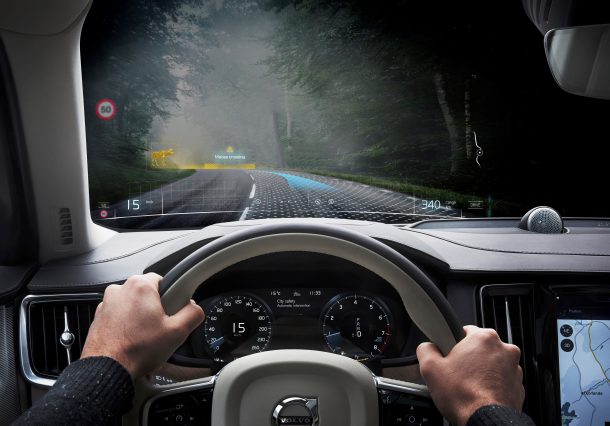Volvo to Implement 'Mixed-reality' Development Tool

Like all automakers, Volvo is keen to promote itself as a cutting-edge manufacturer, and now has a new tool in its arsenal to impress tech-obsessed shareholders. Thanks to a corporate partnership with Varjo, the brand says it will begin implementing the latest in VR headsets to help streamline development. However, Volvo’s plan is more concerned with augmenting our existing realities than creating new ones.
By using Varjo’s new XR-1 headset, the automaker believes it can manufacture plausible portions of augmented reality littered with virtual obstacles and encounters that are as real to the driver as they would be to the car — without putting either in any legitimate danger. This is ultimately supposed to allow the company to effectively test real vehicles sporting autonomous hardware while subjecting living subjects to the same experience. But the full depth of these simulations has yet to be explored.
For now, the XR-1 can be used to help Volvo decide what visual cues stand out most to drivers by simulating events like wild animal crossings or road closures. In the future, some vehicles might incorporate expansive head-up displays. By tapping Varjo’s headset to test what locations and imagery are most effectively in drawing the human eye, Volvo could get a head start on the competition. This advantage could spill over into the fine-turning of established active safety solutions while mitigating production costs by eliminating the need for so many prototype models.
Eventually, the automaker intends to use the system to virtually “drive” vehicles that are still in development and test design elements without ever having to fabricate anything physical. While there’s no guarantee it will pay off, it’s an interesting concept that sounds plausible enough on its surface.
“With this mixed reality approach, we can start evaluating designs and technologies while they are literally still on the drawing board,” said Henrik Green, chief technology officer at Volvo Cars. “Instead of the usual static way of evaluating new products and ideas, we can test concepts on the road immediately. This approach offers considerable potential cost savings by identifiying [sic] priorities and clearing bottlenecks much earlier in the design and development process.”
Varjo promises that the headset boasts near-perfect retina resolution and no perceptible lag, which is why you’re supposedly able to get away with wearing one while driving. That combination is said to make the system the most advanced VR headset currently in existence. Pricing is yet to be announced, though should reflect that aspect of the product.
If you want an early taste, Volvo and Varjo plan to display the XR-1 at the Augmented Reality World Expo in Santa Clara, CA, this week. The headsets won’t make their way to the automaker’s R&D facilities until later this year. For a time, the two companies’ partnership will be exclusive. Yet Varjo has already indicated that it intends to make its products and services are available to all manufacturers once its exclusive deal with Volvo ends. The XR-1 will be a free agent before the start of 2020.
[Images: Volvo Cars]

A staunch consumer advocate tracking industry trends and regulation. Before joining TTAC, Matt spent a decade working for marketing and research firms based in NYC. Clients included several of the world’s largest automakers, global tire brands, and aftermarket part suppliers. Dissatisfied with the corporate world and resentful of having to wear suits everyday, he pivoted to writing about cars. Since then, that man has become an ardent supporter of the right-to-repair movement, been interviewed on the auto industry by national radio broadcasts, driven more rental cars than anyone ever should, participated in amateur rallying events, and received the requisite minimum training as sanctioned by the SCCA. Handy with a wrench, Matt grew up surrounded by Detroit auto workers and managed to get a pizza delivery job before he was legally eligible. He later found himself driving box trucks through Manhattan, guaranteeing future sympathy for actual truckers. He continues to conduct research pertaining to the automotive sector as an independent contractor and has since moved back to his native Michigan, closer to where the cars are born. A contrarian, Matt claims to prefer understeer — stating that front and all-wheel drive vehicles cater best to his driving style.
More by Matt Posky
Latest Car Reviews
Read moreLatest Product Reviews
Read moreRecent Comments
- ToolGuy If these guys opened a hotel outside Cincinnati I would go there to sleep, and to dream.
- ToolGuy Michelin's price increases mean that my relationship with them as a customer is not sustainable. 🙁
- Kwik_Shift_Pro4X I wonder if Fiat would pull off old world Italian charm full of well intentioned stereotypes.
- Chelsea I actually used to work for this guy
- SaulTigh Saw my first Cybertruck last weekend. Looked like a kit car...not an even panel to be seen.




































Comments
Join the conversation
Uhhhh..FUBAR! (Google it if necessary!)
".. now has a new tool in its arsenal to impress tech-obsessed shareholders." Geely owns Volvo outright, and is itself privately held. No shareholders or Wall Street to impress. Li Shufu runs the outfit he started making fridges. I can't quite figure out what this set of goggles is really meant to do, mixing reality with artificiality, but the porn industry is no doubt panting at the possibilities.